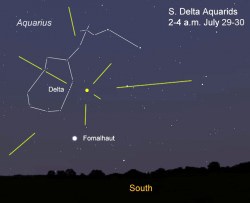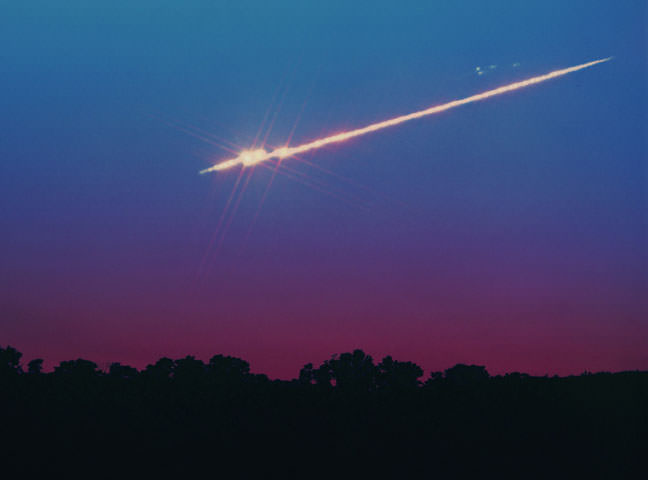With the southern Delta Aquarid meteor shower peaking tomorrow morning, the summer meteor-watching season officially begins. While not a rich shower from mid-northern latitudes, pleasant weather and a chance to see the flaming remains of a comet seem motivation enough to go out for a look. With a rate 10-15 per meteors an hour you’re bound to catch a few.
The farther south you live, the better it gets. Observers in the southern hemisphere can expect double that number because the shower’s radiant will be much higher in the sky. Any meteors flashing south of the radiant won’t get cut off by the southern horizon like they do further north.
The annual shower gets its name from Delta Aquarii, a dim star in the dim zodiac constellation Aquarius. You don’t need to know the constellations to enjoy the show, but if you know the general direction of the radiant you’ll be able to tell shower members from the nightly sprinkle of random meteors called sporadics. If you can trace the path of a meteor backward toward Aquarius, chances are it’s an Aquarid.

There are actually two meteor showers in Aquarius active this time of year – the northern and southern Delta Aquarids. The northern version sprinkles fewer meteors and peaks in mid-August.
The Southern Deltas peak over the next two mornings – July 29 and 30 – but will be out all week. Both serve as a warm-up for the upcoming Perseid meteor shower that climaxes on August 12.
Tonight’s shower will suffer no interference from moonlight, making for ideal meteor watching. Unfortunately, Perseid rates will be reduced by a bright waning gibbous moon.
Don’t be surprised if you see a few Perseids anyway. The shower’s just becoming active. If you can draw a meteor’s trail back to the northeastern sky, it just might be a member. Read more about Perseid prospects from our own David Dickinson.

Nearly all meteor showers originate from clouds of sand to seed-sized bits of debris spewed by vaporizing comet ice as they swing near the sun. The Delta Aquarids may trace its origin to dust boiled off Comet 96P/Machholz.
The best time to watch the shower is in the early morning hours before dawn when the radiant rises in the south-southeastern sky above the bright star Fomalhaut. Try to get away from city lights. Point your lawn chair south and spend some time in heavenly contemplation as you wait for Aquarius to toss a few javelins of light your way.

